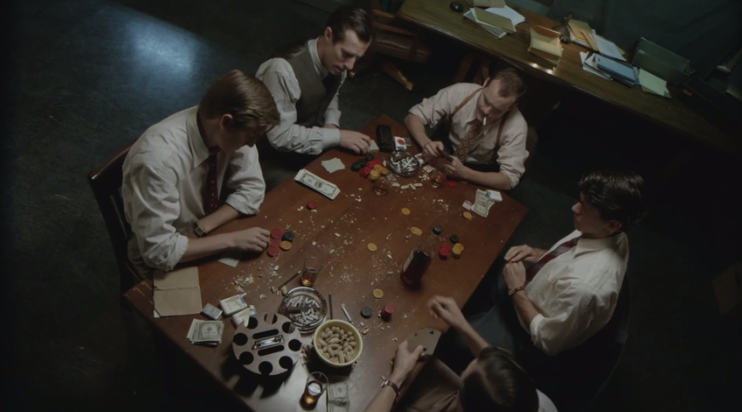The eleventh episode of “Manhattan” turns up the heat as spies, secrets, and lies threaten to derail the entire bomb project at Los Alamos.
The episode opens in Werner Heisenberg’s laboratory, where three Nazi officers approach “Magpie,” a spy who has been secretly passing information about the German atomic program to the United States. “The Führer himself is touring the facility,” the officer tells him. “He would like to shake your hand!”
When the officers lead the man into another room, Adolf Hitler is not there. Instead, it’s the man’s wife, sitting in a chair with a gun pointed directly at her head. After Magpie admits to spying for the Americans, the officer kills his wife. “I spared her the shame of living with a traitor,” he tells him. The officers cut Magpie’s head off and send it to Washington, D.C.
“Magpie” was actually the codename for a Nazi mission to gather intelligence in the US during World War II. The mission involved Nazi agents sailing from Kiel, Germany in a submarine and coming ashore in Maine on November 30, 1944. Within a month the German agents turned themselves in to the FBI. Some historians think that the goal of this operation was to learn about America’s atomic bomb program; other historians are more dubious that the mission had anything to do with the Manhattan Project.
Back at Los Alamos, Occam, the man in charge of security and personnel, confronts Col. Alden Cox about the incident. “Magpie is dead and now we have no eyes on Heisenberg because somebody talked, somebody right here,” he tells the Colonel. Now Occam wants to put microphones in every office at the Hill.
Though there is no evidence that suggests the United States had a spy within the German atomic program, keeping the Manhattan Project secret was a top priority. Army intelligence agents censored mail and monitored outgoing phone calls at Manhattan Project sites to make sure no information about the Project got out. “At one time when I was in military intelligence I monitored phone calls,” recalls Hope Sloan, a secretary in military intelligence at Hanford. “I was supposed to find out if anyone said anything that sounded wrong or to find out if anyone were speculating about what was going on at the plant.”
Back at Los Alamos, Frank Winter bumps into Reed Akley, the director of the Thin Man group who is on his way to see President Roosevelt in Washington, D.C (or so we think). Akley informs Winter about Glenn Babbit’s departure from the implosion group, which comes as a shock. Fed up with all the lies, Babbit tells Frank he will be going to work for Oppenheimer directly.
If news of Babbit’s exodus wasn’t bad enough, Frank now has to deal with Occam, who knows that Frank is the only one besides Colonel Cox who knew about Magpie. With Sid Liao’s suspicious behavior and Glenn Babbit’s communist associations, Frank appears to be at the center of a Los Alamos spy ring, and Occam is determined to get to the bottom of it.
Back at the laboratory, Charlie Isaacs is facing an even bigger problem. After playing poker with some members of the Thin Man group, Charlie confronts Tom Lansfield about groping his wife, Abby. After punching him in the mouth and knocking him to floor, Charlie tells Tom never to go near his wife again. But before Tom leaves, he tells Charlie that he knows all about his secret partnership with Frank and that when Akley gets back, it will all come crashing down.
 With the entire project hanging in the balance, Frank and Charlie must figure out a way to get Lansfield fired and removed from Los Alamos. With little time to spare, Charlie asks Abby to plant secret documents underneath the floorboards inside Tom’s house to make it seem as though he were stealing secret information.
With the entire project hanging in the balance, Frank and Charlie must figure out a way to get Lansfield fired and removed from Los Alamos. With little time to spare, Charlie asks Abby to plant secret documents underneath the floorboards inside Tom’s house to make it seem as though he were stealing secret information.
While compartmentalization helped keep the Manhattan Project secret, top-level scientists were encouraged to discuss information about the project with one another. J. Robert Oppenheimer, Los Alamos’ laboratory director, convened weekly colloquia for division leaders and key staff to solve difficult problems.
“The colloquia were one of the most important things,” recalls Ben Diven, a physicist at Los Alamos who attended several of the meetings. “Everybody who was a staff member at the lab was allowed to come to colloquium and Oppenheimer insisted that everything could be discussed there.”
The rivalry that exists between the two design groups in “Manhattan” was never a reality at Los Alamos during the war. “The idea was to have various group leaders usually describe what the group was working on and what their main problems were,” says Diven. “Very frequently it would turn out that somebody who had not associated with them at all would come up with an idea of something that would actually be important.”
“Darn near everything…was discussed quite openly in the colloquia that we held one evening a week every week,” says Roy Glauber, a physicist who worked on the project and later won the Nobel Prize in Physics in 2005. “The discussions that took place there involved, as well as I can tell, nearly every detail of the entire project.”
At the end of the episode, Paul Crosley makes a shocking discovery after glancing over Frank notes. The Thin Man group has been secretly performing calculations on implosion the whole time, and Frank is the one leading the effort. He immediately shares the discovery with Akley, who has just returned from his trip to Washington – Washington state, that is.
Akley deliberately lied to his colleagues, telling them he was going to DC rather than Hanford. It is likely that he lied for compartmentalization reasons. We can only imagine how Akley will respond to the news of Winter clandestinely appropriating his group during next week’s episode!





